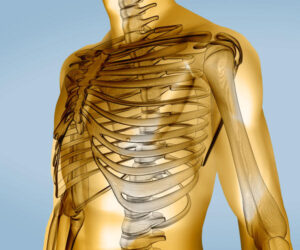There is no specific test for diagnosing costochondritis. The patient’s medical history and a physical exam are the mainstays of diagnosis. So, if the onset of your chest pain or costochondritis was following a traumatic event, an impact or lifting heavy weights in the gym, someone barging into you or after weeks of intense study for exams sitting with poor posture in bed or scrunched up on the sofa, then the likelihood is it’s mechanical or postural and you don’t need the intense barrage of extremely expensive, time consuming and worrying tests and investigations which are commonly done, regardless of the logical and extremely likely physical nature of the diagnosis.
The doctor will press on your chest to reproduce tenderness over the affected rib joints, usually over the fourth to sixth ribs in costochondritis, and over the second to third ribs in Tietze syndrome. In costochondritis with unknown causes, there is no apparent swelling of the costochondral joints, although there is swelling and tenderness of the rib-cartilage junctions in Tietze syndrome. Some doctors use the terms costochondritis and Tietze syndrome interchangeably but Tietze syndrome has a sudden onset without any preceding respiratory illness or any history of minor trauma and there is frequently radiation of pain to arms and shoulders, as well as pain and tenderness associated with swelling at the point that hurts.

Tests are sometimes needed to rule out other conditions that have similar symptoms but are more worrying, like heart disease. So if you’re overweight, inactive and diabetic, your blood pressure is high, your diet is designed to make you ill and you take a lot of medication, then heart disease is a clear possibility and needs to be investigated.
Blood tests and a standard chest X-ray are usually not helpful in diagnosing costochondritis.
However, after sternum surgery, or for people at risk for heart disease, doctors will be more likely to do tests if you have chest pain and possible costochondritis to be certain you do not have any infection or other serious medical problems.
To determine if infection is the cause of chest pain, doctors will:
Look for signs of infection such as redness, swelling, pus, and drainage at the site of surgery
Order a more sophisticated imaging study of the chest called a gallium scan, which will show increased uptake of the radioactive material gallium in an area of infection
Check the white blood cell count to see if it is elevated, a sign of infection
Order a chest X-ray if pneumonia is a suspected cause of chest pain
Order an ECG and other tests if a heart problem is suspected
Costochondritis is a less common cause of chest pain in adults but occurs fairly frequently in people who have had chest drains or cardiac surgery. The diagnosis can only be reached after excluding more serious causes of chest pain that are related to the heart and lungs. The appropriate studies, such as ECG, chest X-rays, blood test for heart damage, and other studies will be done as indicated. Any chest pain in adults is taken seriously and not ignored. If you are concerned, consult your doctor.
Source : NHS